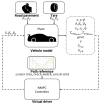Investigation on the Model-Based Control Performance in Vehicle Safety Critical Scenarios with Varying Tyre Limits
- PMID: 34450816
- PMCID: PMC8399611
- DOI: 10.3390/s21165372
Investigation on the Model-Based Control Performance in Vehicle Safety Critical Scenarios with Varying Tyre Limits
Abstract
In recent years the increasing needs of reducing the costs of car development expressed by the automotive market have determined a rapid development of virtual driver prototyping tools that aims at reproducing vehicle behaviors. Nevertheless, these advanced tools are still not designed to exploit the entire vehicle dynamics potential, preferring to assure the minimum requirements in the worst possible operating conditions instead. Furthermore, their calibration is typically performed in a pre-defined strict range of operating conditions, established by specific regulations or OEM routines. For this reason, their performance can considerably decrease in particularly crucial safetycritical situations, where the environmental conditions (rain, snow, ice), the road singularities (oil stains, puddles, holes), and the tyre thermal and ageing phenomena can deeply affect the adherence potential. The objective of the work is to investigate the possibility of the physical model-based control to take into account the variations in terms of the dynamic behavior of the systems and of the boundary conditions. Different scenarios with specific tyre thermal and wear conditions have been tested on diverse road surfaces validating the designed model predictive control algorithm in a hardware-in-the-loop real-time environment and demonstrating the augmented reliability of an advanced virtual driver aware of available information concerning the tyre dynamic limits. The multidisciplinary proposal will provide a paradigm shift in the development of strategies and a solid breakthrough towards enhanced development of the driving automatization systems, unleashing the potential of physical modeling to the next level of vehicle control, able to exploit and to take into account the multi-physical tyre variations.
Keywords: double lane change; model-based control; safety optimization; tyre thermodynamics; tyre wear; vehicle dynamic potential; vehicle safety; weather influence.
Conflict of interest statement
The authors declare no conflict of interest.
Figures




















References
-
- West W., Limebeer D. Optimal tyre management for a high-performance race car. Veh. Syst. Dyn. 2020:1–19. doi: 10.1080/00423114.2020.1802047. - DOI
-
- da Cunha Rodovalho E., de Tomi G. Reducing environmental impacts via improved tyre wear management. J. Clean. Prod. 2017;141:1419–1427. doi: 10.1016/j.jclepro.2016.09.202. - DOI
-
- Singh K.B., Sivaramakrishnan S. An adaptive tire model for enhanced vehicle control systems. SAE Int. J. Passeng. Cars-Mech. Syst. 2015;8:128–145. doi: 10.4271/2015-01-1521. - DOI
-
- Frezza R., Saccon A., Bacchet D. SmartDriver: A sensor based model of a car driver for virtual product development. Proc. IEEE/Asme Int. Conf. Adv. Intell. Mechatron. 2003;1:366–370.
-
- Bellet T., Deniel J., Bornard J.C., Richard B. Driver modeling and simulation to support the virtual human centered design of future driving aids; Proceedings of the INCOSE International Conference on Human-Systems Integration (HSI2019); Biarritz, France. 11–13 September 2019; pp. 11–13.
MeSH terms
LinkOut - more resources
Full Text Sources

